How to improve tuition rates without bleeding clients
So many guitar teachers would love to make more money from their private lessons but either lack inspiration as to how to do that, or are held back by their reservations.
I’m going to give you five ways you can increase the price of your guitar lessons without losing your students, simply by
If you’re looking for more guidance and resources to help you become a more confident guitar teacher, check out TopMusicGuitar.

Table Of Contents:
1. Making The Decision To Increase The Price Of Guitar Lessons
2. Reservations About Putting Up Guitar Lessons Fees
3. Why You Should Put Your Prices Up NOW!
4. Change Your Mindset
5. 5 Ways to Increase Guitar Lesson Prices without Losing Students
5.1 Increase Your Guitar Lesson Prices for All New Students Starting Immediately
5.2 Have a Fixed Annual Tuition Price Increase
5.3 Have an Annual Registration and/or Materials Fee
5.4 Raise Guitar Lesson Prices for Your Current Students
6. Still Not Convinced You Should Raise Your Guitar Lesson Prices?
7. Conclusion On How To Raise The Price Of How Much Your Guitar Lessons Cost
When it comes to deciding whether to change how much your guitar lessons cost, there are a few important factors to weigh up:

In an ideal world you would simply increase the prices your current students are paying. You’d send out an email saying that tuition costs will be increasing from date x and the student will pay you more money and everybody is happy.
But it’s not that simple, is it? Your mind gets flooded with worry and doubts:
We let our worries get in the way of taking a simple action that will result in a direct benefit for us, and an indirect benefit for our students. We put it off, procrastinate, and don’t make any changes. Instead, we choose to suffer in silence and sacrifice what’s better for us.
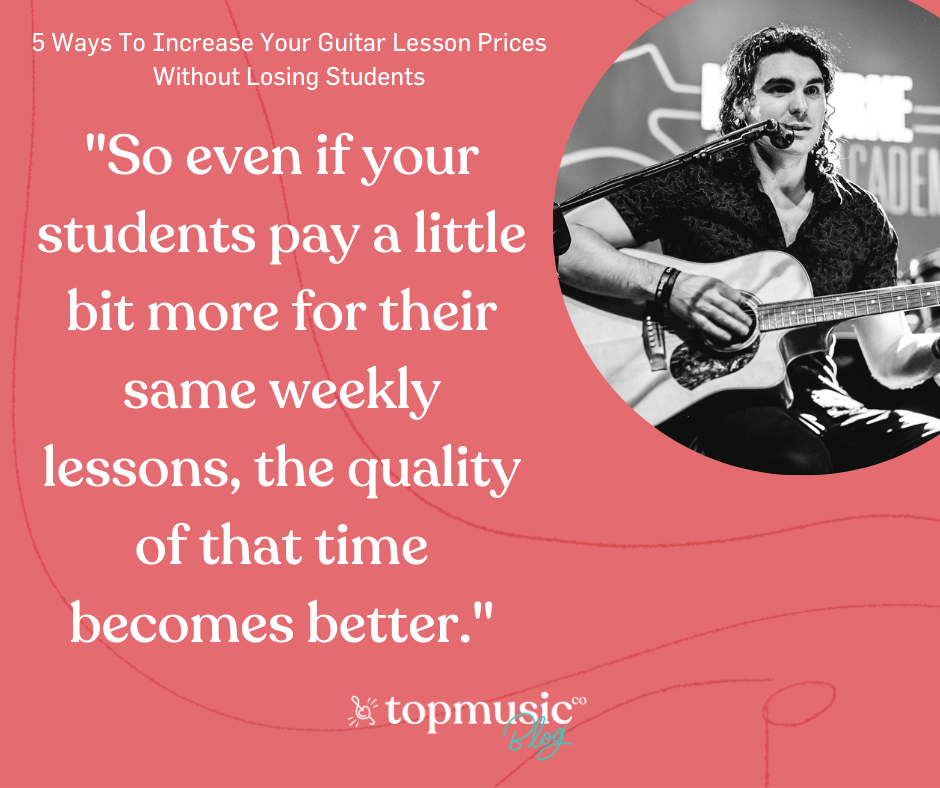
We’ve all felt the worries of increasing the prices, but ultimately, we need to do what is better for us.
So let’s take a mindset shift:
If you make more money, you can have a higher standard of living.
If you have a higher standard of living you become a better, happier and healthier person.
When you are better, your students benefit from learning with a better version of you!
So even if your students pay a little bit more for their same weekly lessons, the quality of that time becomes better.
You’ll also realise that when you raise your prices, a lot of your headaches go away and you have a better overall teaching experience…
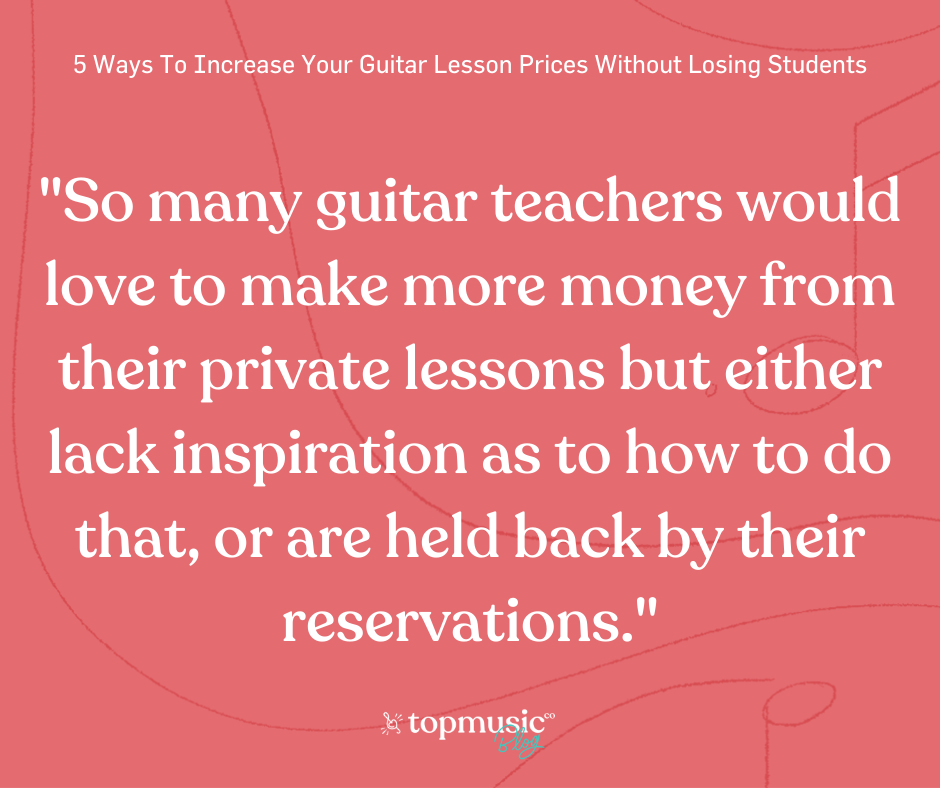
When you stop holding onto the bad clients simply because you need their money, you’ll quickly find yourself in a better position to offer lessons at a discounted price to a long time student or a pensioner who really needs it.
Imagine how much better your life would be right now if every student you had paid you $10, $20, even $50 more a week?
Look, you’re not going to be able to keep everyone. And some people won’t be able to afford $50, but there are a lot of people who will.
I know it’s tough, but if you sell yourself on how much better life is going to be for you, it feels easier. Ultimately, if you’re not in a good position yourself, then your students won’t get the best from you.
Now that we’ve got our mindset shift out of the way, I want you to think about what price you would actually like to charge for guitar lessons.
Write it down on a piece of paper.
Related: TC255: Part Two: Teaching Guitar the 80/20 Pareto Principle with Michael Gumley
Now I hope you wrote down a number that you want for guitar lessons, not a number that you hope students will pay. It’s very important that you charge what you think you’re worth and lose any fear of losing students over your price and work for less than what you’re worth.
Remember that you’ve probably put 10,000 hours and thousands of dollars into mastering your instrument and teaching skills, you deserve to be paid as much as other professional guitar teachers.

These are five ways you can effectively increase the cost of guitar lessons without losing all your students in the process.
Starting today all new students pay the new price for guitar lessons that you wrote down on your piece of paper earlier. No backsies!
Don’t worry about students being scared away by the higher price.
If they don’t know the old price, they don’t have a comparison to complain about.
Related: 10 Ways to Get More Guitar Students
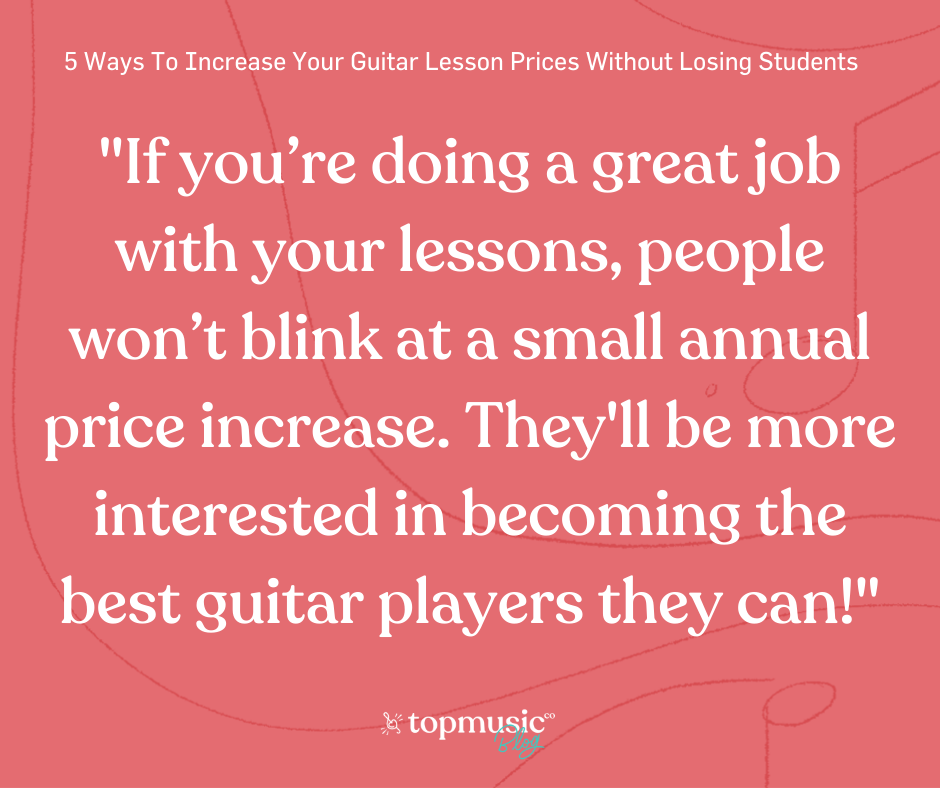
Write into your lesson policy that your tuition fees will increase by a small amount every year. I personally like to say 2% so it keeps up with inflation. Talk new families through this in their first guitar lesson.
Then send families an email 30 days in advance of the update with a heads up of upcoming pricing. This way people expect an increase every year. If they complain, you can avoid an argument by reminding them that they agreed to it in the intro lesson.
Lastly, if you’re doing a great job with your lessons, people won’t blink at a small annual price increase. They’ll be more interested in becoming the best guitar players they can!
Having a signup fee in their first guitar lesson to cover the cost of some materials, photocopying and utilities is something you should implement straight away.
Write it into your guitar lesson policy that it’s charged as an annual levy so that your students help contribute to your running costs.
They usually do this with their schools and other memberships so it’s perfectly reasonable for them to do it at your music school, too.
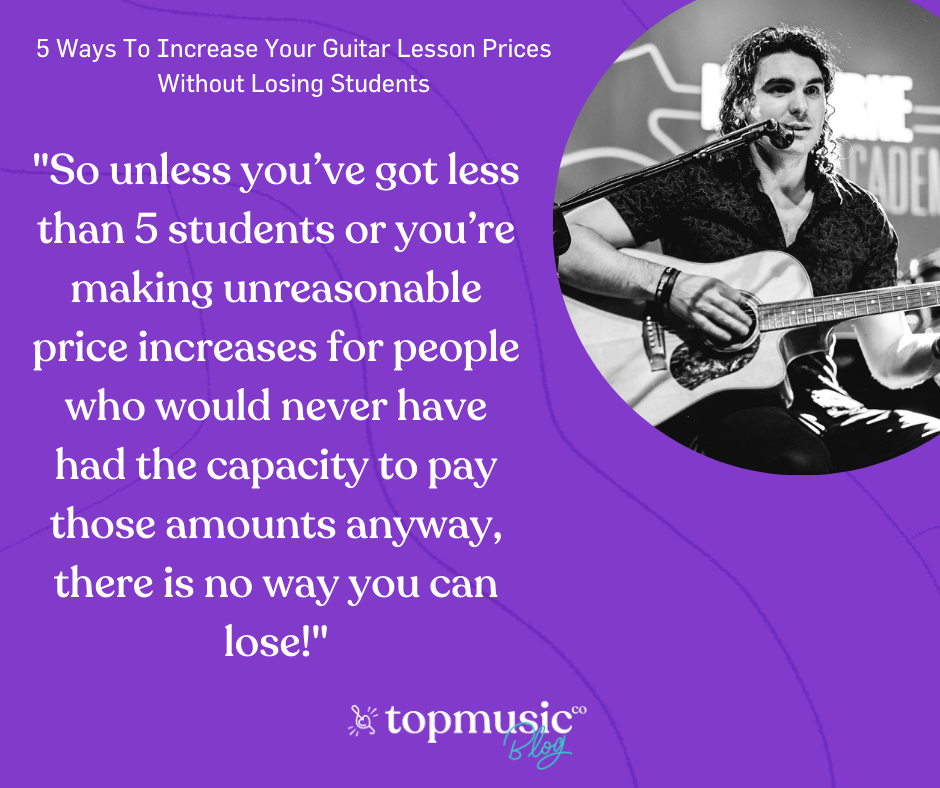
Here’s the big scary one.
You need to call all of your current students and inform them price increase for their guitar lessons, and the reasons why it is happening. You’ll be pleasantly surprised to find that:
This is perfectly okay because you’re going to replace them with people ready to pay the new tuition rates anyway.
My last tip is a super easy one that can make you anywhere from a little bit of extra money on the side right up to tens of thousands of extra dollars if you have a large studio and lots of students.
Make students purchase a method book and music theory book when they sign up and every time they complete their book and are ready for the next one.
Organise with your local music store a bulk deal or special rate so you can buy cheap and sell to make a profit.
Don’t just stop with books. Have a small inventory of guitar picks, strings, capos and even beginner guitars which you can sell to students on an as-needed basis. While this technically isn’t raising guitar lesson prices, it’s still allowing you to make more money per student with minimal effort.
You could also sell pre recorded lessons or online guitar lesson videos for any student wanting extra tuition during the week but who are unable to book in an extra lesson.
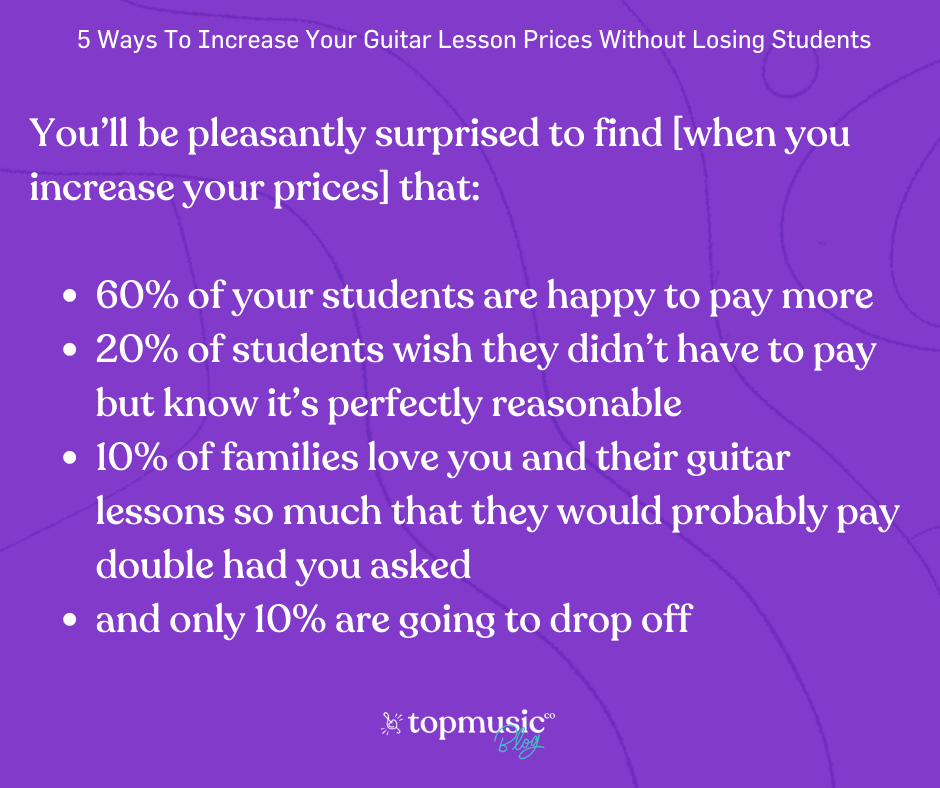
Now just in case you’re not sold on the idea of raising prices and might still be concerned about losing students, let me pitch you a hypothetical scenario:
Related: Keep Your Guitar Students from Quitting with 6 Steps for Better Results
Even if you had 30 students paying for $30 per lesson and you upped your rates to $40 and 10 people quit:
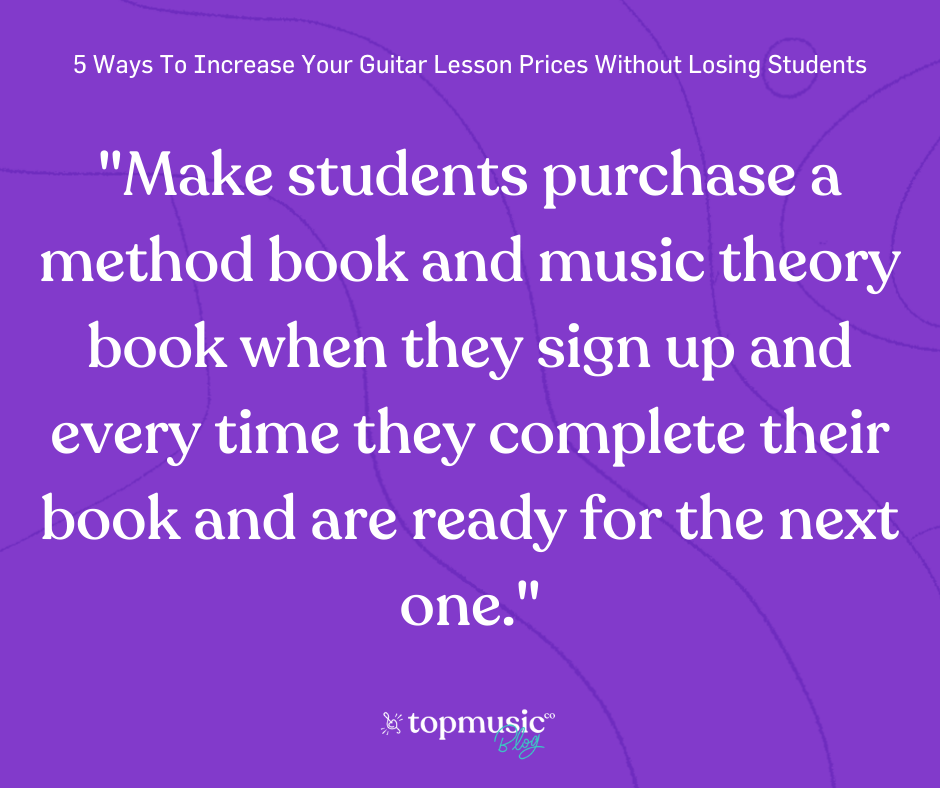
These hypothetical situations have also been on small $10 increases. If you’re making more significant increases, the take home money only ever goes up.
So unless you’ve got less than 5 students or you’re making unreasonable price increases for people who would never have had the capacity to pay those amounts anyway, there is no way you can lose!
If you implement just one of these five ideas, you’ll be able to start bringing in more revenue right away into your guitar lessons.
Marketing for guitar students can be overwhelming and frustrating.
We’ve been there and figured out the 10 BEST ways to get more students without wasting time or money. So we’ll get to the point and save you time. Download your FREE eBook 10 Ways to Get More Guitar Students.
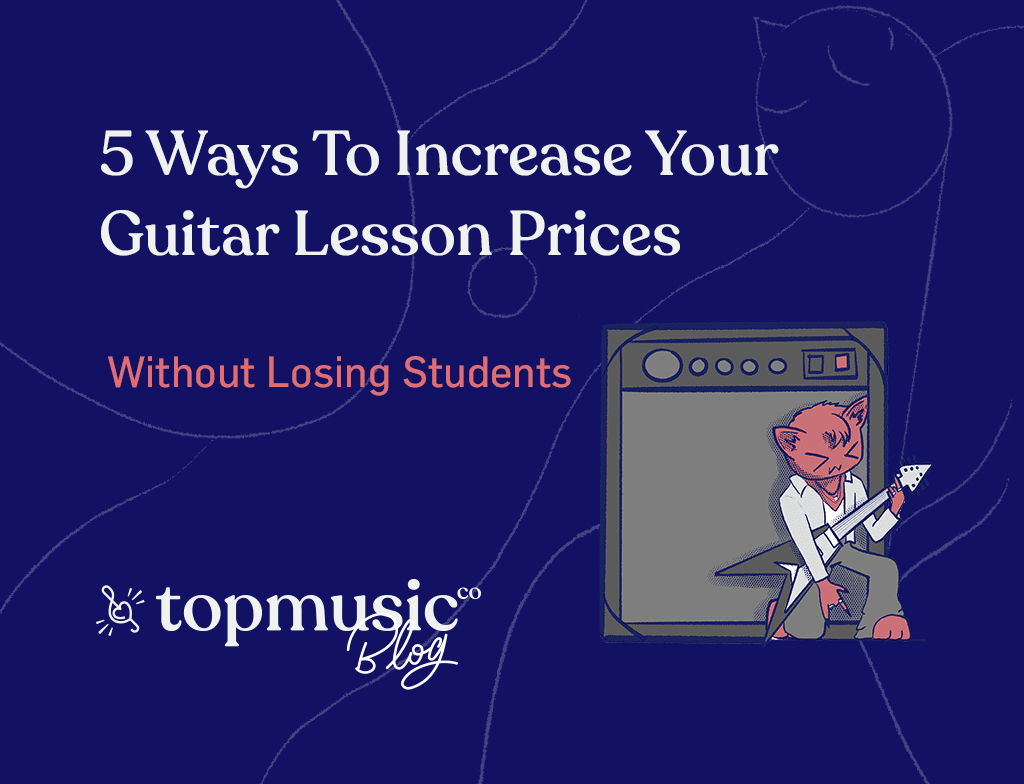
Lee says:
Great article! I teach piano, but have been considering increasing my rates for some time, but covid came. I was able to raise rates for my new students last fall, and planned to increase rates for my returning students for the fall to keep the rates consistent over everyone. But the economy right now is so bad, I’m concerned with push-back for even a $5 increase per lesson. Any thoughts or recommendations?